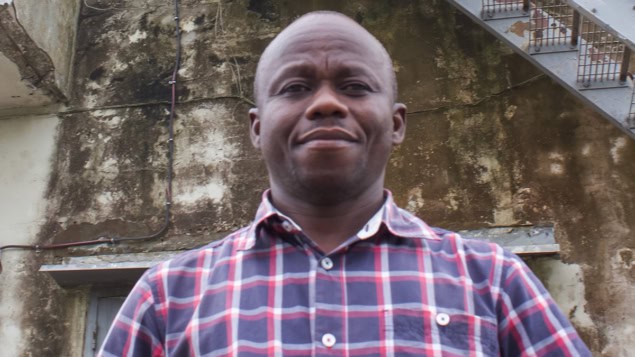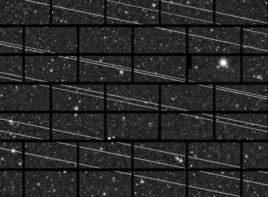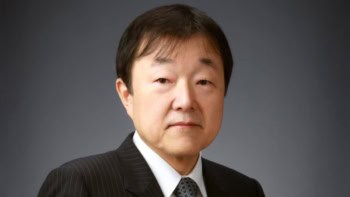Linda Nordling speaks to Bernard Asabere, director of Ghana’s first astronomical telescope

A careful crawl is the only safe way to negotiate the last few kilometres of potholed road leading up to the old telecommunications satellite dish in Kuntunse, Ghana. In the distance the 32 m dish towers over fields of maize, banana and cassava. From afar it looks derelict, like a technological relic. But under the grime, the dish is getting a second life as Ghana’s first ever astronomical telescope, under the leadership of Bernard Asabere, the telescope’s director and Ghana’s first homegrown space scientist. “When building this thing, we weren’t even 100% sure that we would succeed,” he admits. There are still a bunch of technical snafus to be resolved before they get useful data from observations, but the “first light” data collected earlier this year show promise.
In the 1980s and 1990s this dish linked Ghana with the rest of the world. But as undersea cables took over Africa’s telecommunications traffic, this and other such giant satellite dishes became obsolete. That is, until a group of South African astronomers, eager to build observing capacity on the rest of the continent, took an interest in the hulking behemoths. It was Michael Gaylard, the former director of the Hartebeesthoek Radio Astronomy Observatory, who first came up with the idea of retrofitting disused African satellite dishes as telescopes. He used Google Maps to scour the continent for such things, and Kuntunse was one of the sites he identified. It is the only one up and running so far, and was formally launched last month.

Three more are in the works in Zambia, Madagascar and Kenya. The long-term plan is to hook these up with new telescopes in Namibia and Botswana, as well as existing facilities in South Africa, to form the African Very Long Baseline Interferometry (VLBI) Network. Ghana’s location just north of the equator means it can view the entire plane of the Milky Way galaxy, thus filling a gap in global VLBI observations. Kuntunse could also become one of the receiving stations of the Square Kilometre Array (SKA), and will also play an important role in training African astronomers to be ready to spring to work when the entirety of the SKA network comes online in a few years’ time. All that is some way off, explains Asabere, as the Kuntunse telescope’s current motor can’t keep up with the VLBI observations made by more advanced telescopes further north, so that needs to be upgraded.
Crooked journey
Asabere’s path to astronomy was a crooked one – and as bumpy as the one leading to his telescope. As a boy growing up, he remembers seeing the dish when travelling between his home village of Aduamoa and Accra, the capital. But the thought that he would one day work there never crossed his mind. He studied physics at the Kwame Nkrumah University of Science and Technology in Kumasi, near his home. After graduating, he taught physics at a girl’s school for six years – there were few other job prospects for physics graduates in Ghana at the time. In 2006 he moved to Gothenburg, Sweden, to study for a Master’s degree in engineering at Chalmers University of Technology. There was an astronomy course in the curriculum. “I did it because I had to,” he recalls with a shrug. After all, what would a Ghanaian do with astronomy?
After graduating, he taught physics – there were few other job prospects for physics graduates in Ghana at the time
Quite a lot, as it turned out. In 2010, after completing his Master’s, Asabere was headhunted by representatives of South Africa’s SKA project. It envisaged using antennas dotted around the continent, but for this it needed African astronomers. Asabere completed his PhD at the University of Johannesburg between 2011 and 2015, during which time he travelled intermittently to Kuntunse. It took the Ghanaian government several years longer than expected to give the Kuntunse telescope project its full support, including an agreement to help maintain the facility. But by the time Asabere moved back to Ghana permanently in December 2015 all the agreements were in place and work had started on the refurbishment.
Asabere relishes the small victories. The first time the dish moved at all, after 30 years fixed on the zenith, it caused a stir in the surrounding community. “Most often they were just curious about what we were doing,” says Asabere. The renovation of the telescope has brought much-needed employment to the area, and business is booming at Kuntunse’s only hotel. However, electromagnetic signals from dwellings built on the surrounding land might interfere with observations, and a solution has yet to be found.
Today, Asabere’s day-to-day work includes testing the telescope’s technical capabilities, supervising engineering and maintenance work, leading outreach projects (he visits schools and colleges to talk to students about careers in astronomy), and helping train the telescope’s future staff. At the moment there are two Ghanaians studying for PhDs and five Ghanaians studying for Master’s degrees as part of the SKA’s Africa-wide astronomy training programmes. Asabere has also had plenty of opportunity to train his “soft skills” in his negotiations with Ghanaian decision-makers about the way forward for the observatory and astronomy in general in the country.
The main drawback, he says, is the persistent lack of financial commitment from the Ghanaian government. “That’s a bit of a headache. Most of the local stakeholders and policy-makers on the project are non-astronomers with little interest in the field, so most of their actions are directly and indirectly not in favour of the project.” However, this irritating state of affairs is more than made up for by the things he values about his job: the opportunity to practise his profession on his home soil – at last – and the chance to raise awareness about astronomy, especially among young people who, like him, are unaware of the opportunities that await them out in the world. He tells them that their every conceivable dream is achievable with the right resources, time and commitment: “I encourage them to go for it irrespective of how unrealistic it might seem to them today.”



